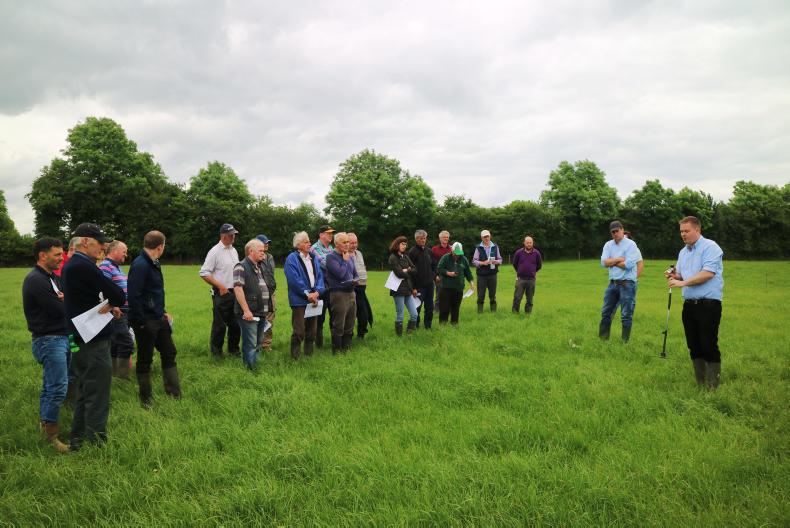While the high grass growth rates experienced in recent weeks have been greatly welcomed, they have presented challenges for most farmers in maintaining swards at the desired grazing heights and quality.
Overcoming these challenges and putting plans in place to get back on track was a discussion point at Friday’s Teagasc Grass10 sheep farm walk held on the farm of Alan Cole, Moatfield House, Athy, Co Kildare.
Teagasc researcher Philip Creighton said weather in recent weeks has been ideal for a surge in grass growth.
“Soil temperatures are running 3 degrees celsius higher than normal and with this heat in the ground and then rain, grass growth has really exploded.
“Areas with a cover of grass on them have doubled in yield in the space of a few days”, he said.
Sheep specialist Ciaran Lynch said that the greatest challenges are being faced on farms with a set stocking system in place or where paddock sizes are too big for the number of sheep grazing.
This has quickly resulted in a situation where sheep are not able to graze out the paddock leading to lower quality stemmy grass developing and performance suffering as a result.
More paddocks
The two Teagasc men advised farmers attending to try if possible to put in some paddocks so that peak growth can be managed better and surplus grass removed as high quality baled silage.
Lynch advises farmers to select one area of the farm as a trial and to subdivide larger areas to experience the benefits that can be achieved.

“Paddock grazing doesn’t have to cost a fortune. Alan is working with three strands of electric wire and temporary stakes and its working great for him.
“If you believe anyway in the message, try one area and see how it goes for you. The one piece of advice I’d give is to start in an area with good boundary fencing and start with a good shock in the fence.
“This is the secret, if sheep get accustomed to the electric fence at the start, they will settle much quicker”.
Managing surplus grass
Philip says that once paddocks are in place, the aim should be to focus on trying to manage surplus grass.
“The aim at present is to try and keep quality by having somewhere around 10 days grazing ahead of animals. Start off with small steps.
“For example if you have over 20 days grazing ahead of sheep, remove some areas to bring this down to 15.
“Over time you will become more confident and can learn better how much to take out depending on how quick your farm can grow grass.
“Taking these surplus areas out will help to maintain quality but it will also serve in giving you a source of high-quality silage in the region of 75DMD for feeding in late pregnancy. It is important to come in and cut quickly, maybe a week after sheep should be grazing it.”
More bales
Ciaran acknowledges that this will deliver a higher number of bales per acre than many people are accustomed to.
“There will be a balancing point. We are not saying to come in and bale two bales/acre but at four to five bales per acre it is ideal to save high quality winter feed and promote quick recovery in the sward.
“The mistake is often made of looking at these paddocks and then spreading a bag of fertiliser and delaying cutting for another few weeks.
“This defeats the purpose and will only serve to deliver a lot more bales that many farmers won’t have a need for.
“You have to look at the bigger picture and the benefits that cutting quickly will have on silage quality, grass quality and having good quality aftergrass coming on stream.”
Surplus grass
Philip advised farmers to be careful not to take out too much surplus grass due to a risk of running too tight on grass in the short-term.
He says that there may be when you have no other choice than to graze grass at a height greater than what is desirable.

In such instances, the secret to maintaining animal performance is to avoid forcing sheep to graze down the sward to 4cm. Instead the aim should be to graze off the good quality grass and either use dry hoggets or ewes or top to graze out the sward.
Post-weaning management
This followed on to advice on management of swards post-weaning.
The ideal time is where aftergrass swards are coming on stream as this will limit any setback in performance.
Alternatively, lambs should be given access to swards with leafy grass and moved on to fresh grass once the best of the grass has been consumed.
“Ideally lambs will be going into swards with a grass height of 6cm where aftergrass swards are available. In swards with grass height of 7cm to 8cm, the general approach is to allow lambs to graze out to 6cm and use weaned ewes to graze out the remainder of the sward.
“As more lambs are drafted, there will be better quality grass coming on stream for ewes and this will help ewes to recover condition well in advance of the breeding season”, says Philip.
